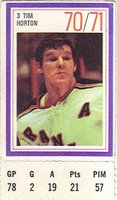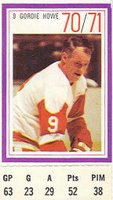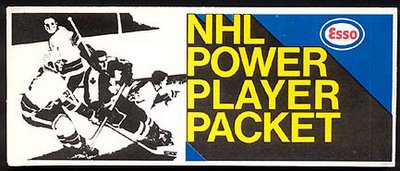Phil Esposito
 From the spring of 2008...
From the spring of 2008...Although the Montreal Canadiens won the Stanley Cup in the year of Power Players, another team, the Boston Bruins, was slithering in the background and dramatically struck the following season by winning the Cup. If the term glamourous could be applied to any team during this period, it would be to the Bruins. Bobby Orr, perhaps the greatest defenseman in league history, revolutionized the way the position was played. Matinee idol Derek Sanderson was emerging as a star, and a supporting cast of players, some prominent, some merely there to play specific roles all gelled to create a fearsome machine who collectively came to be known as The Big Bad Bruins.
Most hockey experts would agree that Orr was the team's best player. An unassuming superstar from Parry Sound who let his play do the talking for him, in person Orr was shy and reserved, with a workmanlike personal typical of small-town Ontario. As a counterpoint, the team's other star was a big, flamboyant center from Sault Ste. Marie, Ontario. Phil Esposito had quite simply evolved into a hockey celebrity of unprecedented proportions. In that one season, Esposito single-handedly smashed the NHL record for goals in one season. In the 1968/1969 campaign, Bobby Hull of the Chicago Black Hawks potted 58 goals - a record may believed was unassailable. Just two years later, Esposito, who used to center for Hull before being cast off by the Blackhawks in a trade to the Bruins, did the unthinkable and scored 76 goals.
The magnitude of the feat instantly propelled Esposito to super-stardom becoming the game's most recognizable face, a role he relished. With his swarthy good looks and a persona matching his on-ice stature, he instantly became a media darling. On the ice, he instilled fear in his opponents; every time he touched the puck in the offensive zone, opponents and their fans collectively held their breaths hoping he wouldn't do what had become customary - putting the puck in the net. Wherever he went, he was surrounded by bright lights with microphones with long cords thrust toward him. This was no meek and polite Canadian - Esposito exuded confidence, flair and a zip of panache, ingredients that formed the foundation of something called media savvy. Phil Esposito relished every moment of his fame.
No matter where the Bruins played, arenas sold out just so those fortunate enough to get tickets could catch a glimpse of this mega-hockey star. Kids everywhere who followed hockey now looked to Espo as the man, and tried to copy every little move or gesture they might pick up on television. Of course I wasn't immune, as I soon was caught in his spell. My second season of Don Mills Civitan house league hockey began in the fall of 1972, and came just weeks after the conclusion of the Canada/Russia series. Next to the star of the series, Paul Henderson of the Toronto Maple Leafs, the second most important fixture for the Canadians was Phil Esposito who balanced the team's offensive attack.
Hockey is a game built on a rich tradition, so if a date or an occasion is particularly significant, it is often marked with a pre-game ceremony. Usually, such ceremonies occur at center ice when each team lines up on their respective blue lines to participate. During the Russia series, a memorable moment occurred prior to the start of game five in Moscow. This was the first of four games played in the Soviet Union, and to welcome the Canadians, the Russians pulled out all the stops. The festivities began when Olga Barinova, a star from the Moscow Ice Ballet skated onto the ice to offer the Canadian team a traditional gesture of hospitality to guests of the Soviet Union - a loaf of bread with salt on top. This was followed by the presentation of flowers by 44 figure skaters who presented one flower to each player on both sides. Once the teams returned to their respective blue lines cordially faced each other, the PA announcer began player introductions. With each introduction, the player whose name was just called skated a few strides forward, acknowledged the crowd with a simple nod and moved back. The sixth player called out was Phil Esposito - remember, the entire Soviet Union and all of Canada were glued to their television sets; Esposito made a few strides forward, but suddenly lost his footing and fell right on his behind.
Always the showman, Esposito added his own brand of improvisational flair to his live pratfall. As he landed, he extended his legs skyward in an exaggerated V, and as he got up, bowed to the crowd, including a sweep of the hand holding the flower that had just been presented to him that was befitting of a Shakespearean actor asking a maiden for her hand in matrimony. The crowd ate it up. It was magic, and at that moment, the only person in the world who could have pulled it off was Phil Esposito.
Fast forward to the following spring, and I found myself on a house league team that burned up the entire season posting win after win. The team, Peck Jewellers, was so good in that we made it all the way to the league finals. The only thing standing between us and a great big trophy was a team sponsored by a local radio station called CHUM-FM. This was a team led by a superstar player who by all rights was way too good for this league named Brett Lawrence, a multi-sport wizard in our neighbourhood, and any hopes that our team had of tasting glory were dashed by his superior play. When we lost, we had our own centre ice ceremony following the game. Members of the winning side were presented with gleaming trophies while we had to settle for some nicely embroidered crests. After our teams lined up and my name was called, I skated over to collect my consolation prize, but as I was reaching to receive it, fell down right at center. I pulled a Phil Esposito only a few weeks after the maneuver had been invented. When I got back up, I tried to do my own Esposito-like bow - unfortunately, I lacked the requisite amount of gravitas required to pull it off, and all I heard was pin-drop silence. All these years later, memories of that incident still make me squirm.

Big Phil Esposito's impact extended to our home too. On one particular Saturday afternoon during the season following the big series, my older brother received a call from a friend asking if he would be interested in attending the Leafs/Bruins game that evening at Maple Leaf Gardens. Getting tickets to a Leaf game was next to impossible under the best of circumstances, but on the a night when the Bruins came to town? Forget it - absolutely the hottest ticket in town. Though not really a hockey fan, my brother accepted on the spot, and used the opportunity to rub his good fortune in my face. That evening I watched the game knowing full-well that my brother had great seats and was watching the Bruins live and close-up. I'd have to wait until the next day to get the details.
When morning arrived, and we gathered at our pale yellow linolium table designed at the height of the jet age when anything was possible, and our mom served us up a stack of pancakes. "You're not going to believe what happened last night at the game" he started, as he stuffed a triangular morsel of six pancake layers that had been stabbed by his fork into his mouth. "What? What?" I implored. He was deliberate in taking his time chewing and swallowing, wiping his face with his sleeve, and taking a big gulp of milk.
"So our tickets last night were almost at ice level but beside one of those tunnels that takes you under the Gardens, and that tunnel led to the Bruins dressing room (hockey players stopped using the term "dressing room" in around 2004, and replaced it with the term "locker room", thus erasing a small vestage of its gentlemanly roots). Just before warm-ups started, you could tell the players were about to come out onto the ice. Our whole section didn't even seem to be paying attention, but then all of a sudden, guess who walked out of the tunnel and just stood there beside us?"
"Okay, I know, but who?" I said.
"Big Phil Esposito." By this point, he was dripping with smugness and continued. "Yup, Espo was standing there, and it was like one of the Beatles had come out. Everyone in the whole section just stopped what they were doing and just began staring at him. Of course he was loving it, but pretending that he didn't notice. So then, guess what I did."
"Tell me, tell me!"
"With a bunch of people looking, I looked right at him and said 'Hey...Phil'"
"You said 'Hey Phil' to Phil Esposito? No way! What did he do then."
"He looked at me, and nodded."
"Phil Esposito nodded at you?" I couldn't believe my ears, this was even more significant that Neil Armstrong walking on the moon, or seeing one of the Toronto Maple Leafs in person.
"Oh yeah." He said. From the way he described the entire scene I could just see how this one guy could just lasso an entire crowd through the aura he radiated. It was like that proverbial person who they say lights up a room when they walk in. No matter the importance of any other event. That person just showing freezes everyone else. Phil Esposito was that unstoppable force of nature who had the world on a string in the 1970's.




